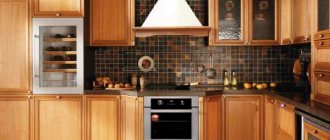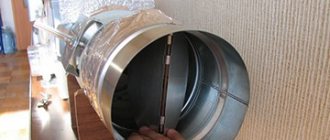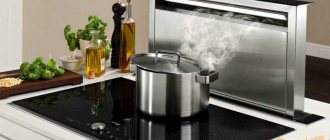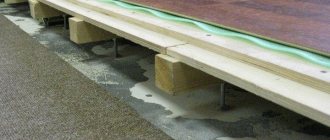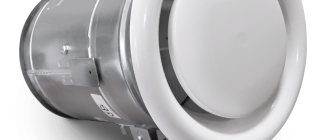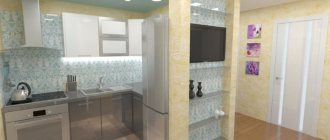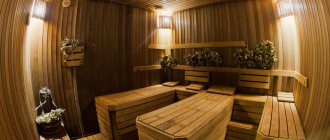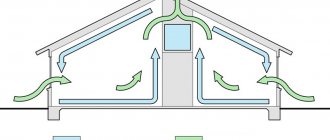Hoods in the kitchen are necessary to eliminate unpleasant odors that form during cooking. Fumes from cooking dishes rise to the ceiling. If the hole for extracting contaminated air cannot cope with its volume, then after some time it will become difficult to breathe in the kitchen. To prevent this from happening, you need to install a kitchen hood. It will ensure air circulation and will remove already contaminated masses from the room.
Kitchen hoods come in different types. They differ in operating modes and installation methods. Therefore, before installing a hood in your kitchen, you must first clarify what mode of operation is necessary in your case, and then how to properly install the hood in the kitchen?
Hood operating modes
All kitchen hoods differ in how they work. Each room has its own mode of polluted air intake. There are only two types of kitchen hoods.
According to the operating modes of devices for forced ventilation in the kitchen, there are the following types:
Flow-through
In such devices, air from the room is always discharged to the street. Typically, the installation of such a hood requires special skills, since it is necessary to connect the hood air duct and the chimney pipe. Air exchange is provided by a built-in fan, which increases the traction force. Therefore, hoods with flow mode are considered more powerful and better for large rooms. The fan takes exhaust air from the kitchen into the chimney and creates a pressure difference. Thanks to this, clean air enriched with ions enters the kitchen.
Flow hoods are considered better than circulation hoods, since they can operate in both exhaust and recirculation modes. Also, in hoods with exhaust mode, filters are installed on the fan that trap grease. If there are no such filters, then grease will begin to accumulate on the fan blades and on the walls of the entire structure. This filter needs to be changed periodically. The exact service life is determined by the manufacturer. If you choose a more budget model, then it may not have filters at all. Then you will have to take care of the hood more carefully. It will be necessary to constantly remove the accumulated layer of fat.
Advantages of flow hoods:
- High power of operation;
- No consumables are needed; installed grease filters last for several years;
- Can be built into kitchen furniture;
- Doesn't make as much noise as circulating ones.
Minuses:
- The window must always be open, since the hood takes air from the kitchen and does not return it;
- In winter, heated air is taken in and replaced with cold air;
- The plate should be close to the ventilation hole to avoid complicated installation.
Circulating
Such hoods do not remove dirty air from the room to the street. There are filters installed inside the device, through which the air is purified. After that he goes back to the kitchen. In addition to a grease filter, a carbon filter is also installed, which eliminates unpleasant odors. To keep your kitchen always clean and smelling nice, you need to replace both filters on time.
Conventional filters for purifying air from fat are made of padding polyester or non-woven fabric. They require frequent replacement. To change filters less often, you can install a reusable metal one. Such filters are made of steel or aluminum. Caring for them is simple - just wash them periodically with running water and some dishwashing detergent.
Some models use not one large metal filter, but two or three small ones, which are more convenient to clean.
A carbon filter can last from several months to several years, depending on the degree of air pollution in the kitchen.
The advantage of circulation hoods is their ease of installation. They do not need to be connected to the chimney. But such devices are not popular, since they are not much cheaper than flow-through devices, but are much weaker.
Most often, circulation hoods are installed where the ventilation system is not installed with a strong air flow from powerful models. For example, in old apartment buildings or private houses.
Advantages of circulation models:
- Can be installed in houses with poor ventilation systems that cannot cope with large air flows;
- Mounts anywhere, no need to connect to a common shaft;
- Easy to hide in a closet or cover with decorative panels;
- You can choose a compact model, since high power and strong traction are not required;
- Electricity consumption is less than that of flow ones;
- Longer service life due to less load on the motor;
- It is not necessary to install it next to the shaft, which means the hob can be installed anywhere.
Flaws:
- Filters need to be changed frequently;
- It is necessary to periodically remove and clean the grease filter;
- Such a hood should not be placed directly above the stove, since during the combustion of gas, carbon monoxide is released, which will be distributed throughout the kitchen.
Design advantages
Typically, an inclined hood is distinguished by greater power and productivity. This is due to the peculiarities of its functioning: air is drawn in during the process of natural rise, without excessive energy consumption. More powerful motors, efficient cleaning filters, together with the angular location of the air intake, make kitchen hoods an excellent choice with many other advantages:
- they are more convenient to install, do not limit the use of wall cabinets installed nearby, and allow their doors to be opened freely;
- increased efficiency of air exchange allows you to quickly remove unpleasant fumes and odors from the room, even in comparison with the most powerful analogues of other types;
- the advantage of air exchange results in savings on electricity, which becomes noticeable with frequent use of the device;
- the use of more advanced electric motors reduces noise and ensures their quietest operation in comparison with other types of models;
- design features ensure ease of installation, which does not require special skills and a complex set of tools;
- such devices are more ergonomic, they are comfortable when working near the stove, and create conditions for convenient access to the entire space of the hob;
- Thanks to its modern design and wide range of models, it looks great in the interior of any kitchen.
What power should the hood have?
The power of the hood is directly related to the amount of air that the device can take from the room in a certain time. Calculating the required power is not difficult. Sanitary standards state that a kitchen hood must draw in at least 12 cubic meters in one hour. First you need to calculate the volume of the room. To do this, its area must be multiplied by the height of the ceiling. The resulting result should be multiplied by 12 and another 20% margin added. If gas equipment is installed in the kitchen, then the reserve should be increased to 30%.
Important! For greater accuracy of calculations, you can calculate the volume of all the furniture in the kitchen and subtract it from the total volume of the room. This way you can save on the power of the equipment, and, accordingly, on its cost.
In many modern models of hoods, it is possible to regulate the volume of air taken from the room by changing the speed of the motor. This changes the noise level.
Advantages and disadvantages of kitchen hoods
Hood filters are a consumable item for which you need to allocate funds regularly.
Benefits of installing and using a kitchen hood:
- elimination of unwanted odors;
- removal of moisture, fats and smoke;
- preventing contamination on furniture, walls and ceilings from fumes:
- reducing the risk of gas poisoning if the autonomous heating boiler malfunctions.
Disadvantages of the decision to use a hood in the kitchen:
- expenses for the purchase and installation of equipment;
- regular replacement of filters;
- quite loud noise during operation;
- time and effort for cleaning, washing and replacing consumables.
The hood is an important part of the housing ventilation system, without which it is impossible to achieve a normal level of sanitary standards.
Types of installation
Air circulation equipment differs not only in operating modes, but also in installation methods.
Depending on the type of installation, hoods come in the following types.
Built-in
They can be completely hidden in kitchen furniture. To do this, the hood is installed inside the body of a hanging kitchen cabinet. Typically, such equipment is used in small kitchens, where it is necessary to save space and remove “visual noise”.
Hanging
These hoods have a flat rectangular shape and are installed on the outside of the bottom of a wall-hung kitchen cabinet. Installation of such structures is simple, you can do it yourself. But due to the small dimensions, the filter in these models will need to be changed more often.
Wall hoods
They are installed on the wall above the work surface.
Island
These hoods are often installed above kitchen islands. They are mounted on the ceiling above the stove if it is located in the central part of the room.
Dome
The second name for such devices is fireplace. These are the most common models of hoods. They are installed instead of a wall cabinet and covered with a decorative dome.
Corner
One of the most rare hoods in kitchens. They are installed in the corner of the kitchen unit if there is a hob underneath.
Telescopic
Mounted in hanging cabinets. Equipped with an air intake element that extends automatically. Not popular due to low power.
Retractable
A non-standard hood that is installed in the countertop, and not above it. Pulls out from the table while cooking. Such devices are much more expensive than standard ones, but they save space and are almost invisible.
Installation of hoods by type
The installation method depends on the type of kitchen hood. There are three main types of hoods:
- Built-in;
- Mounted;
- Cabinet mounted.
Built-in hoods are almost invisible. They are installed in a cabinet that must be designed specifically for air circulation equipment. Installation of such a hood is not difficult. The main task is to calculate the dimensions for installing the hood correctly. For a hanging cabinet it should be 30-40 cm less than ordinary ones.
Wall-mounted hoods must be attached directly to the wall. All parts of such hoods are visible, so you need to install them carefully, avoiding large gaps.
All hoods must be installed at a height of 75 cm from gas stoves and 65 cm from electric stoves. This distance is enough so that the equipment does not heat up from the heat emanating from the stove. In this case, you need to take into account the height of the people who will most often cook in the kitchen. The hood should be easy to turn on and off.
At what height from the gas stove should the hood be installed?
Knowing which fasteners to install a kitchen hood on is not enough. It is important to correctly measure the distance for hanging equipment above the gas stove. There are special standards that must be followed if the kitchen is standard.
Also, the installation height of the hood can be changed if provided by the manufacturer.
Traditionally, the system is installed at a height of 65-90 cm above the hob. If you try to place the device a little lower, this may affect performance, because high temperatures may cause some parts to become deformed.
It is advisable to install a hood higher only when a tall person in the family prepares food, and the device has sufficient power and is capable of extracting smoked air even from the bottom of the room.
Organization of ventilation in the kitchen
After installing a hood in the kitchen, the load on the ventilation system will increase. To make its work easier, some make the air outlet larger to increase the volume of air being distilled. However, simply enlarging the outlet hole will not change anything; the cross-section of the main section of the shaft will remain the same. Namely, this section is responsible for the volume of outgoing air.
To increase the power of the hood, you can install an anti-return box. It includes a dynamic valve. It is considered closed when it is in a horizontal position. At this time, natural ventilation works. Air escapes through windows or doors. If the fan is turned on, the pressure begins to build up and the valve rises, the air begins to be discharged outside through the hood. The valve can be made of lightweight materials such as plastic or thin aluminum. The lid closes with a spring.
The advantage of this design is the absence of draft back into the room. This means that odors that are drawn from other apartments into the common riser will not enter the kitchen through the hole.
Why does the hood stop working?
This happens for several reasons:
- The decorative grill covering the channel opening is dirty . This is the simplest option - you can solve the problem on the spot by removing the grille and cleaning it of soot and dust;
- Clogged ventilation duct . The air duct may become clogged with debris and accumulated dust. In winter, an ice build-up may form in it, preventing the outflow of air. Cleaning of the ventilation duct should be carried out by specialists of the management company;
- Dismantling of part of the air main by one or more residents. As a rule, the goal of apartment owners in this case is to increase living space. Such actions are illegal. In such a situation, it is necessary to draw up a collective complaint to the supervisory authorities.
Deciding on the air duct
To create a ventilation system, you can use different types of air ducts. Typically, parts made of aluminum or plastic are used. Each type has its own pros and cons.
Plastic components
Such air ducts are reliable, durable and lightweight at the same time. They are almost inaudible when the hood is operating. Due to the smooth surface of the duct, there is almost no air resistance. Plastic pipes can be hard and static, as well as soft, capable of bending.
Air ducts made of aluminum corrugation
Corrugated pipes are easy to install. They can become deformed and bend. Such an air duct can be installed anywhere. The main advantage of aluminum corrugation is the absence of vibrations. Unlike PVC pipes, it does not shake due to powerful air currents.
The disadvantage of such an air duct is its unaesthetic appearance. A large silver pipe may not fit into a well-thought-out interior. Therefore, it must be hidden behind a box made of drywall or other material. But servicing the air duct becomes more difficult.
How to install a hood?
The installation process for dome and sloped hoods is similar. You can do the installation yourself. Let's take a closer look at the process of attaching a kitchen hood.
Recirculation system
This hood does not need to be connected to a common shaft. It is enough to fix it on the wall above the stove. If the hob is installed at a large distance from the ventilation opening, recirculating hoods are suitable.
Installing a check valve
Installation of the device begins with installing a check valve. This detail prevents air from the common riser from penetrating into the room. You can make such a valve with your own hands. To do this, just buy a small piece of tin material and assemble a box from it. Its size is calculated taking into account the size of the air duct. The diameter of the box should be ¾ of the diameter of the air duct.
After this, a plate is cut out of a 5 mm aluminum sheet, which will act as a damper. It must be installed on a spring to the box so that the air pushes it out when leaving the kitchen. If the damper does not open when there is a reverse air flow, it means that the structure is assembled correctly. The spring is made from ordinary wire. A length of 12 cm, a width of 5 mm and a thickness of 0.3 mm are sufficient.
Important! It is necessary that the spring tension is sufficient to close the forcedly opened lid.
Installation
When the valve is installed, you can proceed to attaching the hood itself. The necessary fasteners will be included with the equipment. Before installation, it is necessary to correctly mark the distance. The operating instructions for the hood will provide guidelines for the location of the hood. After the main points have been marked, you need to check the horizontal position with a level and drill holes in the wall. For reliable fastening, simply insert the dowel and tighten the screws.
How to install an air duct?
Corrugated pipes are easier to install than PVC pipes. It needs to be stretched to a suitable length and the excess cut off. A valve must be installed in the shaft. Its body is attached to the wall. The air duct is connected to the pipe on one side, and the other is inserted into the shaft. To make the connections stronger, use construction clamps. In order to hide the structure, use plasterboard or plastic panels.
Corrugation is used in kitchens where the stove is located far from the ventilation outlet. In this case, the air duct can be extended further. It is worth considering that with each turn and bending of the corrugation, about 10% of its throughput is lost.
Attention! Due to the fact that during operation of the hood all structural elements vibrate, it is necessary to leave a gap between the ceiling and the corrugation. Otherwise, the ceiling may be damaged.
Electrical connection
Before installing the device, you need to clarify the distance from the nearest outlet to it and how long the cord is needed. If the distance is not enough, then it is better to install a new outlet or move an existing one. Extension cords should not be used. Remember that placing an outlet near a sink or heating elements is dangerous. The safest option is to lay hidden wiring on top of wall cabinets.
You can move the socket to the desired location with your own hands. But if you have no experience working with electricity, then it is better to entrust this matter to a professional.
What kind of ventilation is there?
Natural ventilation is the most common type of air exchange due to the difference in the density of warm air inside the room and colder air outside. This type of ventilation is simple to design and operate.
Forced, or mechanical, ventilation of rooms is provided by the use of fans to move air. It can be supply, exhaust or supply and exhaust.
Mixed ventilation is a combination of forced and natural methods of air exchange.
Air characteristics that provide physiological comfort during prolonged and systematic exposure are considered optimal for humans. Most often, optimal conditions mean the following: air temperature - from 21 to 25 ° C, relative humidity - from 40 to 60%, air speed - no more than 0.2-0.3 m/s and the gas composition of the air is as close as possible to the natural composition of atmospheric air (75.5% - nitrogen, 23.1% - oxygen, 1.4% - inert gases).
How to install a built-in hood?
A built-in hood differs from a dome hood only in design. The technical characteristics of these models are similar. In a dome structure, the upper part is only decorative. The built-in design is almost invisible in the cabinet. To hang such a hood, you need to prepare a cabinet that is suitable in size. First, it is attached to the wall at the required distance from the hob. After this, the air circulation equipment itself is installed.
The detailed installation process is described below:
- First you need to dismantle the bottom of the cabinet and shelves, if any. When the bottom is removed, the structure will become less rigid. To make it stronger, you can use metal corners.
- Cut a hole in the cabinet ceiling that fits the size of the air duct. It will be difficult and time-consuming to do this with a regular saw; it is better to use a jigsaw.
- Secure the device in the cabinet with self-tapping screws.
- Secure the cabinet to the wall using dowels and self-tapping screws.
- Connect the air duct to the hood and the ventilation hole.
- Connect the equipment to the electrical network and check its serviceability.
If necessary, you can cover the corrugation with a decorative panel or hide it in a cabinet.
Installation without cabinet
If you do not plan to install a cabinet above the stove in the kitchen, you can use a free-standing hood. Typically, the housing of such models has holes on the back for mounting to the wall. The weight of the structure increases due to the installation of an anti-return valve and duct pipes. Because of this, the standard mounting hardware provided in the kit may not be sufficient.
For additional strengthening, you can build a U-shaped frame. It is better to use metal material for it. For example, a corner or a metal channel. The frame must be installed on the wall using dowels or special bolts in the form of a self-tapping screw at one end and a threaded nut at the other. Install a hood on this structure. Fix the valve on top and secure the air duct.
It will be difficult to cover an air duct with such a hood with panels, and the aluminum corrugation will not look very nice. Therefore, we recommend using white PVC pipes. To prevent air from leaking through the joints, they must be treated with sealant and secured with clamps.
The best hanging models
This list includes kitchen that have good technical characteristics. These models cope with their tasks at a high level.
Darina FLAP 501X
The model is made of stainless steel. There are also glass parts. Operates in withdrawal mode. The air in it is purified using a grease filter. There is no display or timer, but there are three speed modes. Motor power - 110 W. Productivity – 250 cubic meters per hour. The hood has a low noise level - only 35 dB.
Gorenje DU 5345
The device is equipped with a motor that can operate in three speeds. The extraction capacity is 300 cubic meters per hour. This is enough to purify the air in a kitchen of about 10 square meters. To turn on the backlight and switch modes, there are buttons on the front of the case.
LEX Simple 600 Inox
The motor power of this model is 180 W. It works in three modes. The model’s productivity of 340 cubic meters per hour is enough to process a room of 12 square meters. It is easy to install the hood on the wall; its weight is 4.5 kg. The device also has a low noise level and a long service life.
Air exchange in residential premises
The recommended amount of air exchange is determined based on the number of people living in the premises, the area (volume) of the premises and the type of ventilation. For natural ventilation in rooms where there is at least 20 m2 of living space per person, an air flow rate of at least 30 m3 per hour is recommended (but not less than 35% of the volume of the entire room). In buildings where there is less than 20 m2 of space per person, the air exchange should be at least 3 m3 of air per hour for each square meter of living space.
The best built-in models
When choosing a built-in hood, you need to take into account the size of the furniture in which you plan to install it. To simplify the choice, we have collected several models that have good characteristics.
DACH Stefania 60 inox
The built-in kitchen hood model is made of high quality metal. It is retractable. Can operate in drain and circulation mode. Productivity is 760 cubic meters per hour. This is enough to purify the air in a room of more than 20 square meters. The hood motor operates at two speeds. The design includes a grease filter and an anti-return valve.
Elica FILO IX/A/60
This hood has a very high power - 800 cubic meters per hour. It is equipped with electronic clock control. Works in both circulation and outlet modes. For illumination, two 3-watt lamps are used. The model also has a low noise level. It becomes audible only at maximum engine speed.
Kronasteel Kamilla Sensor
The model operates in two modes: circulation and exhaust. During cooking, the hood moves out of the body. The maximum productivity of the device is 550 cubic meters per hour. Motor power - 200 W. There is an indicator of grease filter contamination. Touch button control.
Installation diagrams
The choice of ventilation systems depends on several parameters, including the construction materials of the walls and ceilings of the building, and the area of the room. An important factor is the degree of cleanliness of the outside air; if there are high levels of pollution, there is no reason to pump it into the house. One of the criteria influencing the choice is costs. The ventilation design must take into account the financial capabilities of the residents, but not contradict common sense, otherwise, saving on small things can lead to big problems in the future.
Based on the principle of operation, three types of ventilation can be distinguished:
- natural;
- forced;
- supply and exhaust or mixed.
Natural
This type of ventilation works autonomously due to changes in temperature and pressure. Most often used in apartment buildings, where ventilation shafts are installed along the entire building. In each room, the bathrooms and kitchen are equipped with special ducts that remove exhaust air to the outside. Previously, vents were supposed to serve as supply openings, so we often hear that the room needs to be ventilated. Air also enters through cracks in wooden frames. Unfortunately, today they often install plastic window blocks rather than disrupt the natural circulation of air flows. In this case, you need to provide additional supply ventilation or open the windows more often.
The advantages of this type of system include autonomous operation, low cost of installation and further maintenance, and provision of natural air flows that are more suitable for normal human life.
Forced
The system operates using special electric fans that draw exhaust air and evaporation out through the ventilation ducts.
Forced ventilation is often installed in rooms with large crowds of people: production sites, shopping centers, gyms, airports and train stations, educational premises and institute auditoriums.
The advantages of this type of structure are that they are completely independent of the weather outside, the air purification in the room is due to the filter system, in addition, you can change the temperature of the air flow.
Experts identify the following factors as disadvantages.
- High prices at every stage of work, from the cost of the equipment itself to installation and maintenance.
- Since it is impossible to constantly clean the system parts, and during operation a large amount of dust and dirt settles on them, they themselves are often breeding grounds for fungi and bacteria. As a result, respiratory tract diseases are possible in residents: asthma or allergies. Today, special disinfection complexes have been developed for forced ventilation; they make it more expensive, but the effect is actually insignificant.
Mixed
In this case, natural and forced components are involved in the movement of air flows. Through some openings air enters the house due to pressure differences, and through other channels it is exhausted using fans.
